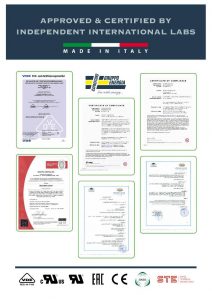
In order to efficiently protect your equipment, it is essential to choose a voltage stabiliser that suits your specific needs.
Here are three steps that will help you choose the voltage stabiliser; however, we always recommend you to contact a specialist.
First step: single-phase or three-phase?
Initially, check if the voltage stabiliser has to work on a single-phase (230 V) or on a three-phase (400 V) network.
Second step: calculate the required power
In order to calculate the total power consumed by the load, you need to know the line voltage and the rating of the equipment that needs to be protected. The ratings are normally mentioned as KW, KVA or in Amps.
Note that the power of voltage stabilisers is indicated in kVA.
It is possible to find out the power consumption of a specific device from its back label or from its instructions.
In case the power consumption is indicated in kVA, you do not have to make any calculations. On the contrary, if voltage, current or kW are indicated you must proceed as follows.
Calculations for single-phase and three-phase networks
Single-phase power sizing if input Voltage or rated current are indicated.
- Determine the input voltage (V) of the equipment or circuit that needs to be protected.
- Determine the rated amperage (A) for the equipment or circuit you want to protect.
- Multiply the voltage by the current. Subsequently, divide it by 1,000 to obtain the size rating in kVA.
- Add 20% to 25% as a safety margin.
Example:
A single-phase device has a nameplate rating of 220 V, 30 A. The single-phase kVA size is then:
- 220 (V) x 30 (A) = 6600 VA
- 6600 (VA) / 1000 = 6,6 kVA (approximately 7 kVA)
- 7 (kVA) x 1,25 (25%) = 8,75 kVA (approximately 9 kVA)
Single-phase power sizing if kW is indicated.
- Determine the kW rating of the equipment or circuit you want to protect, and multiply to 1000 to obtain W.
- Determine the power factor (cosΦ) of the equipment or circuit you need to protect.
- If the power factor (cosΦ) is not specified, consider it equal to 0,7.
- Divide the W by the power factor (cosΦ) and then divide by 1,000 to obtain the size rating in kVA.
- Add 20% to 25% as a safety margin.
Example:
A single-phase device has a nameplate rating of 4 kW, cosΦ = 0,85. The single-phase kVA size is then:
- 4 (kW) x 1000 = 4000 W
- 4000 (W) / 0,85 = 4706 VA
- 4706 (VA) / 1000 = 4,7 kVA (approximately 5 kVA)
- 5 (kVA) x 1,25 (25%) = 6,25 kVA (approximately 6,5 kVA)
Three-phase power sizing if input Voltage or rated current are indicated.
- Determine the input voltage (V) of the equipment or circuit you need to protect.
- Determine the rated amperage (A).
- Multiply the voltage by the current by 1.732 and divide by 1,000 to obtain the size rating in kVA.
- Add 20% to 25% as a safety margin.
Example:
A single-phase device has a nameplate rating of 400 V, 85 A. The single-phase kVA size is then:
- 400 (V) x 85 (A) x 1,73 = 58820 VA
- 58820 VA / 1000 = 58,82 kVA (approximately 60 kVA)
- 60 (kVA) x 1,25 (25%) = 75 kVA
Three-phase power sizing if kW is indicated.
- Determine the kW rating of the equipment or circuit to be protected and multiply to 1000 to obtain W.
- Determine the power factor (cosj) of the same equipment or circuit.
- If power factor (cosj) is not specified, consider it equal to 0,7.
- Divide the W by the power factor (cosj) and divide by 1,000 to obtain the size rating in kVA.
- Add 20% to 25% as a safety margin.
Example
A single-phase device has a nameplate rating of 4 kW, cosΦ not specified. The three-phase kVA is then:
- 400 (kW) x 1000 = 400000 W
- 400000 (W) / 0,7 = 571426 VA
- 571426 (VA) / 1000 = 571 kVA (approximately 580 kVA)
- 580 (kVA) x 1,20 (20%) = 696 kVA (approximately 670 kVA)
Third step: choose the accuracy of the voltage stabilizer.
Finally, the accuracy of a voltage stabiliser strongly influences its price. Therefore, you need to determine the needed accuracy, according to the equipment you want to protect.
For example, if the load to be protected consists of servers or medical equipment, the accuracy must be at least ± 3%.
On the other hand, if the load you need to protect is not so sophisticated (i.e. air conditioning, lighting equipment such as lamps, spotlights, floodlights, etc.) it is recommended to connect a voltage stabiliser having an accuracy less than 3%.

